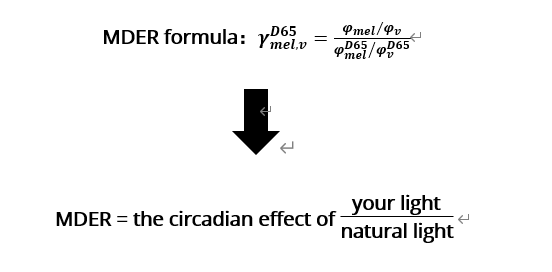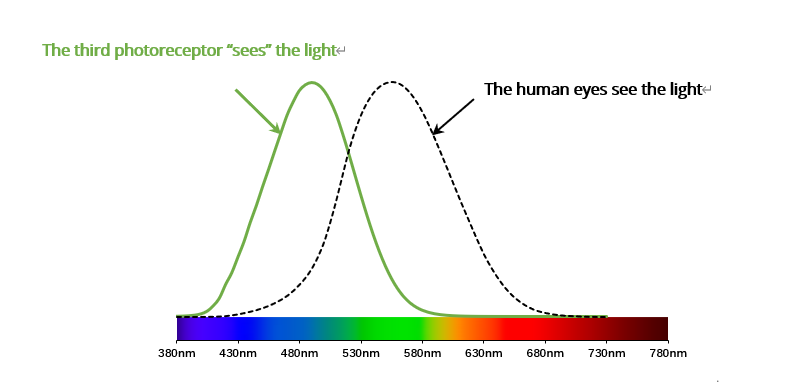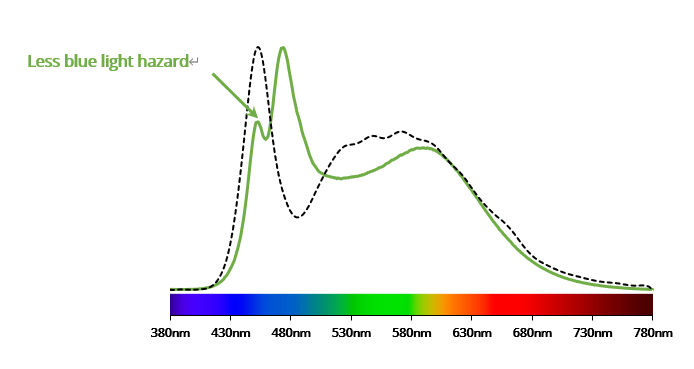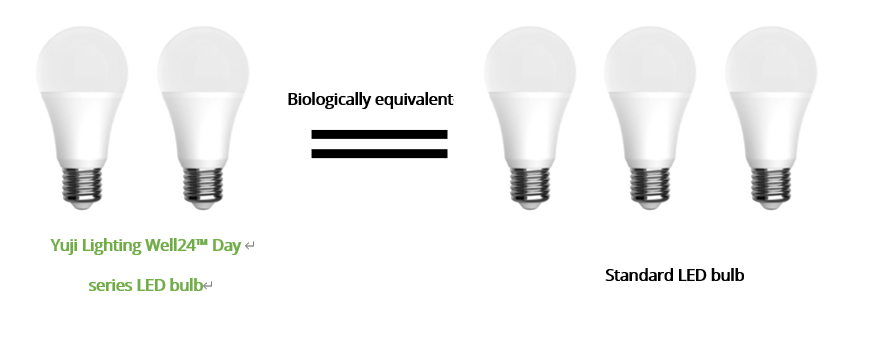MDER, a metric that helps with your lighting design for concentrating
What is MDER and how does it work?
MDER is the abbreviation of Melanopic Daylight Efficacy Ratio, which is defined by the CIE and introduced in the CIE S 026/E:2018 document. Also called the Melanopic DER, this metric is invented for evaluating the circadian effect compared to natural light.
The MDER is a mathematical calculation and the formula of is complicated, however, we can simplify it for easier understanding.

Generally, the MDER can be considered as the circadian effect comparison between your artificial light and the natural light, the higher the MDER result is, the more circadian effect your light is.
What is the circadian effect?
After research, it is known that the work efficiency is related to the sunlight at different times of a day. People are less productive in the early morning and dusk, but are more productive in midday, this phenomenon is called the circadian effect. There is a metric called M/P ratio for evaluating the circadian effect, the higher the M/P ratio is, the more stimulatory effect will be, and the more excitement or focus you will gain.
What is “natural light”?
Natural light is generally recognized as the sunlight, but to evaluate the circadian effect quantificationally, we should choose a standard and consistent reference, hence, the CIE D65 (Daylight 6500K) is selected to be this reference. (Why choose D65?)
Why do we still need MDER beside the MP/ratio?
During the use of the M/P ratio, it is found that it lacks an objective comparison. The M/P ratio cannot intuitively show the actual impact of light on the biological clock. Even if a person is skilled in this art, like a lighting designer, cannot use the M/P ratio to quickly design indoor lighting that matches the biological clock. The MDER is to solve this by applying the ratio of circadian effect which helps with designing the lighting simply and intuitively.
When MDER = 1
This means the circadian effect of your lights is equivalent to the real sunlight. It is an ideal situation, but difficult to achieve by the common CCTs for general lighting.
When MDER < 1
This means you need more lights to achieve an equivalent circadian effect to the sunlight, but there might be challenges:
1. More lights mean more costs.
2. More lights mean more lux, and more lux means the difficulty to balance the demanded and actual light quantity and distribution.
When MDER > 1
Generally speaking, the various CCTs of common LED will not be greater than 1 unless significantly increasing the color temperature, but a high CCT will always cause uncomfortableness and increase the risk of high blue light hazards. After calculation, for the standard LED technology, the CCT should be higher than 7500K to achieve the MEDR > 1, but 7500K is much higher than 4000K which is widely accepted and used in the workplace.
High MDER benefits for the lighting design
The MDER is only for evaluating the work or study environment considering the concentrating effect, therefore it is not related to the design for sleep or relaxed lighting, after understanding this, there are the following steps to utilize the MDER metric during the lighting design:
Step 1. Confirm the “visual lux” you need
During the lighting design for a specific space, the designers always need to calculate and confirm the lux demand. For example, the illuminance in the office should be >500 lux according to the CIE 008/E-2001, here we take this 500 lux as the calculation factor for the next steps.

Assuming the MDER value of the light is 0.8, the calculated lux is >500, then the circadian effect lux you need is 500/0.8 = 625 lux, therefore, the actual visual lux you need is at least 625 lux than 500 lux.
Step 3. Calculate how many lights you need
With the calculated 625 lux and the necessary photometric data (IES/LDT file), designers can figure out how many lights should be used in the space. And the people who live in this space will benefit from the specific circadian effect design to help them concentrate to be more productive.
High MDER is a key factor
A high MDER light can simplify the lighting design and keep a balance between the circadian effect and lux. We can simulate a comparison below when the CCT and circadian effect lux are the same, different MDER values mean different lights.
MDER value | The lights you will need |
0.5 | 2 lights |
0.8 | 1.25 lights |
1.0 | 1 light |
Yuji Lighting WELL24™ Day series, designed for improving the MDER.
The tailor-made spectrum is the secret behind the light
The key factor to generate the circadian effect for concentrating is the enhanced 480nm lighting output in the spectrum. It is found in the 2000s that the energy around 480nm determines the secretion of the melatonin and the melatonin determines our mental condition for focusing or relaxing. It is from a third photoreceptor in addition to rods and cones that “sees” differently compared to human eyes.

The Yuji Lighting Well24™ Day technology increases the intensity of light near 480nm significantly than the common LEDs on the market, restraining the secretion of the melatonin effectively to make our minds clearer and more focused.
Less blue light harzard, but more effective by high MDER
The tailor-made spectrum increases the 480nm and reduces the 450-460nm energy which is recognized as the main wavelength of blue hazard, therefore the Yuji Lighting Well24 Day™ series is not only helping with concentrating, but improving the healthy lighting simultaneously.
The tailor-made spectrum makes the MDER of Yuji Lighting Well24™ Day series can reach 0.967 or even higher whereas a standard LED is only 0.756 when they are the same CCT. Hence, it also saves the number of lights you will need but can reach the light intensity required by the human biological clock.


With high MDER, the Yuji Lighting Well24™ Day can save 30% cost on the number of lights and maintain the same circadian effect, and it is not only about the energy and cost saving, but also meaningful in avoiding unnecessary lux to cause the uncomfortableness. The Yuji Lighting Well24™ Day technology can help with concentrating but just enough lux and appropriate lighting cost.
